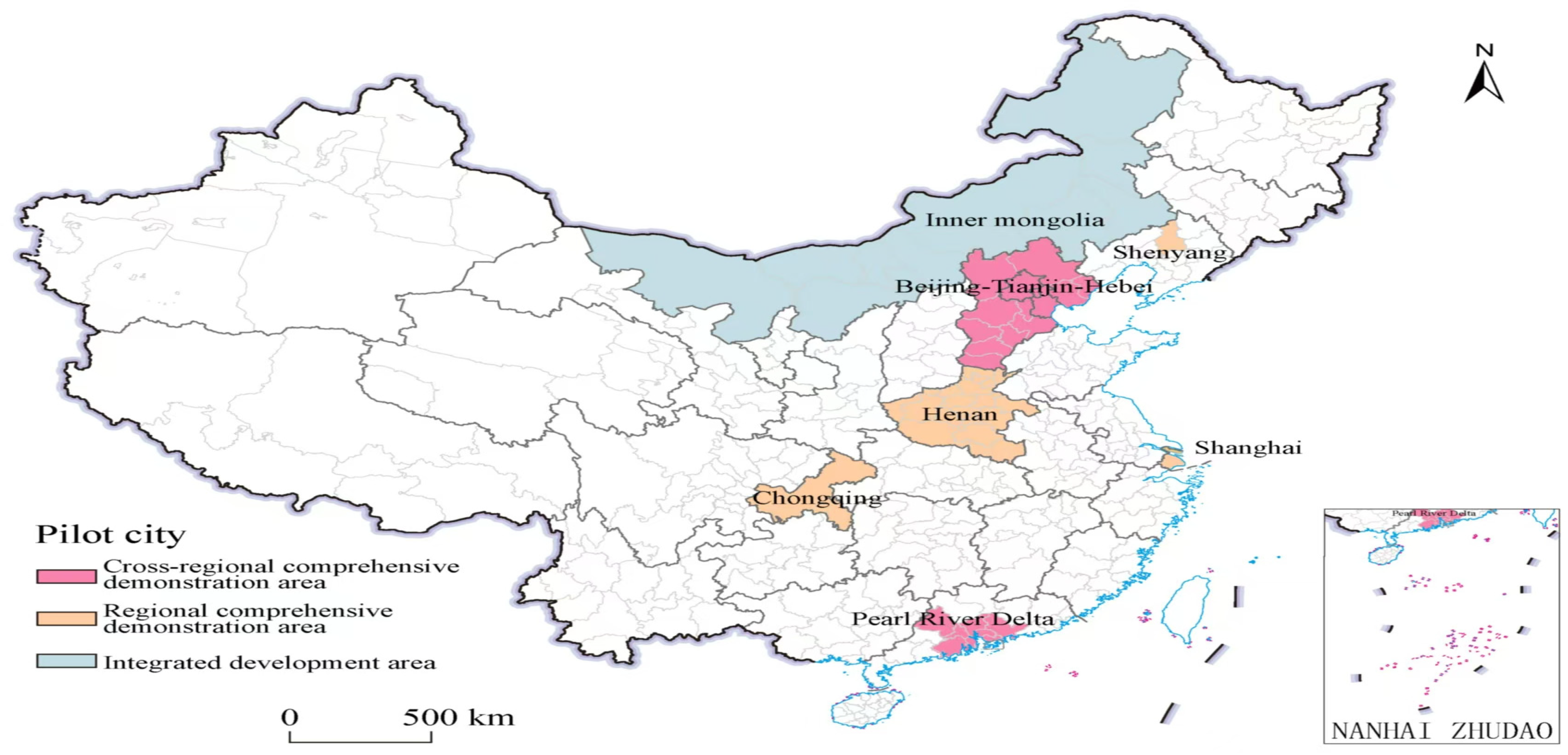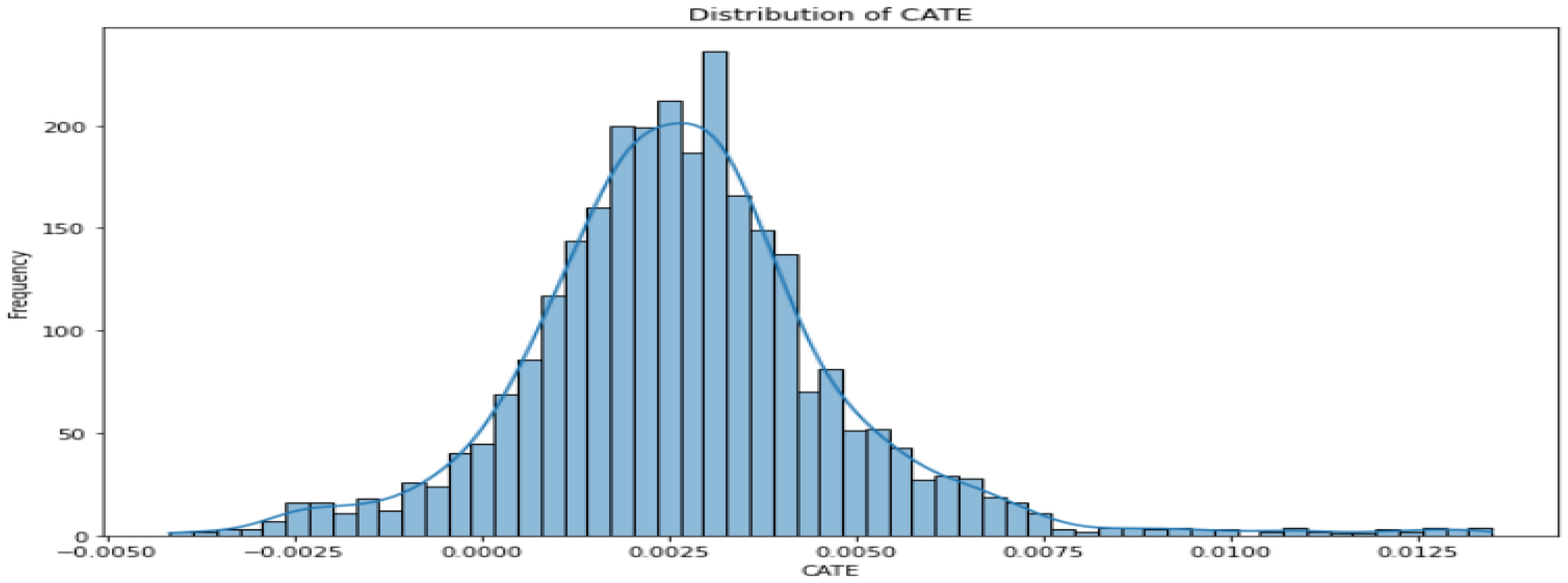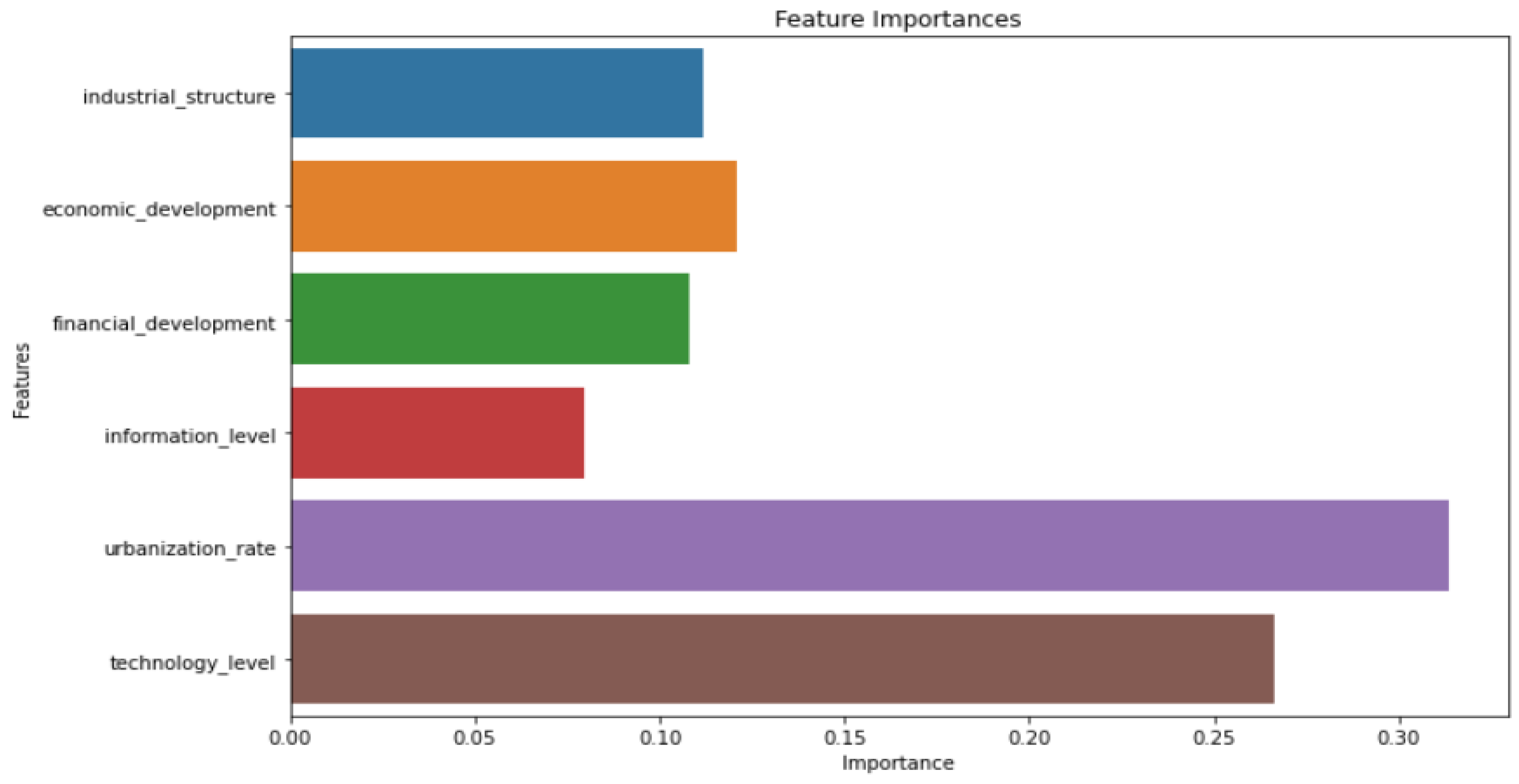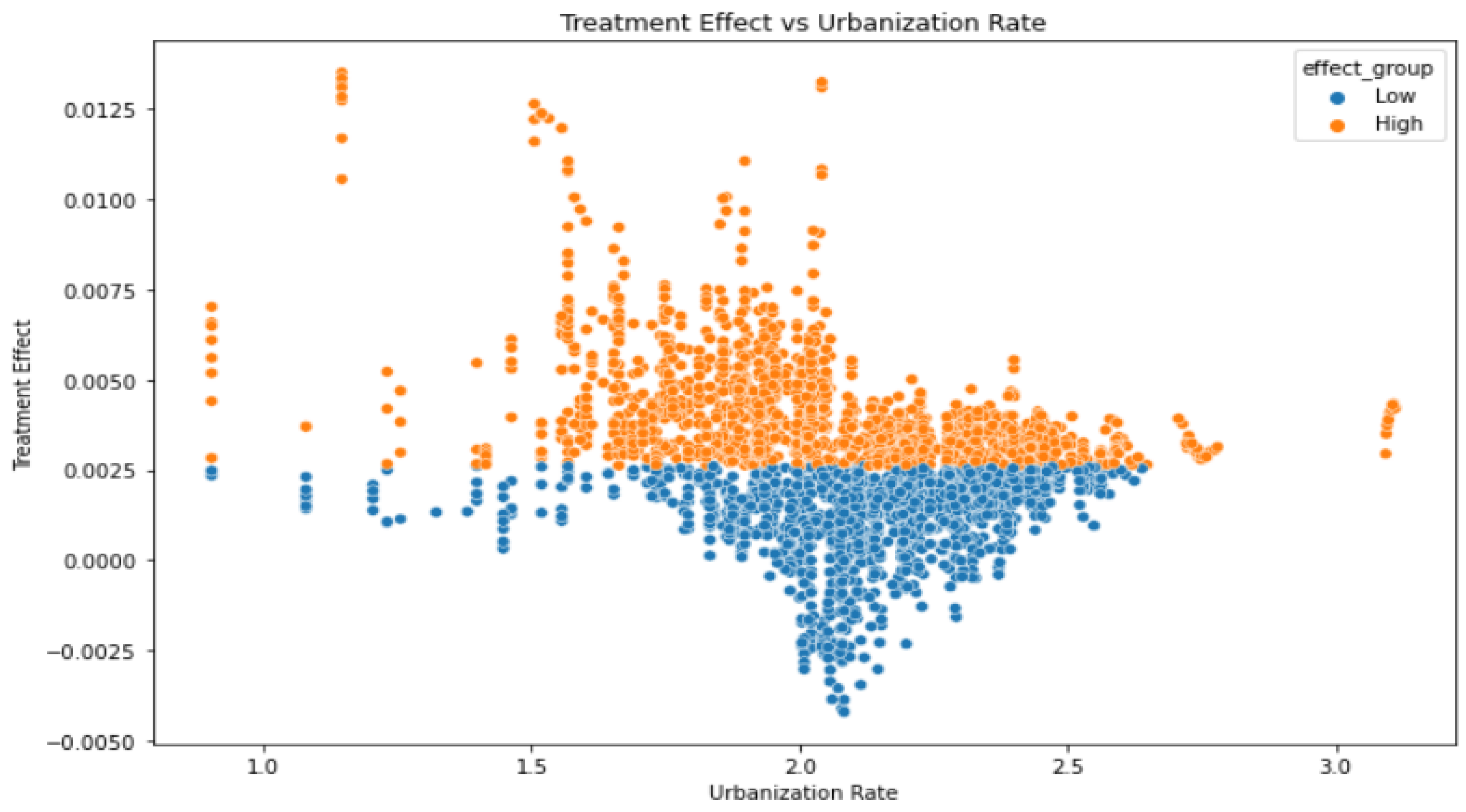The Impact of Big Data Pilot Zones on Urban Ecological Resilience: Evidence from a Machine Learning Approach
Abstract
1. Introduction
2. Theoretical Analysis and Hypotheses
2.1. Direct Impact of Pilot Zone Construction on Urban Ecological Resilience
2.2. Urban Green Innovation, Pilot Zone Construction, and Urban Ecological Resilience
2.3. Energy Utilization Efficiency Improvement, Pilot Zone Construction, and Urban Ecological Resilience
3. Research Design
3.1. Model Design
3.2. Variables
3.2.1. Dependent Variable
Standardize the Extreme Values According to the Direction of the Indicator
Entropy Method Application
3.2.2. Core Explanatory Variable
3.2.3. Control Variables
- Industrial structure;
- Level of economic development;
- Informationization level;
- Financial development level;
- Technological level;
- Urbanization level.
3.2.4. Mechanism Variable
3.3. Data Sources
4. Empirical Analysis
4.1. Benchmark Regression Analysis
4.2. Robustness Tests
4.2.1. Instrumental Variable Method
4.2.2. Dynamic Effect Analysis and Placebo Test
4.2.3. Exclude the Impact of Other Pilot Policies
4.2.4. Eliminate the Influence of Outliers
4.2.5. Consider the Province–Time and City–Time Effects
4.2.6. Reset the Split Ratio
4.2.7. Reset the Dual Machine Learning Algorithm
4.2.8. Reset the Machine Learning Model
| (1) RES | (2) RES | (3) RES | (4) RES | (5) RES | |
|---|---|---|---|---|---|
| The construction of national big data comprehensive experimental zones | 0.0016 *** (0.0005) | 0.0013 *** (0.0004) | 0.0009 ** (0.0005) | 0.0032 *** (0.0004) | 0.0007 *** (0.0002) |
| The first-order term of control variables | Yes | Yes | Yes | Yes | Yes |
| The second-order term of control variables | Yes | Yes | Yes | Yes | Yes |
| Time fixed effects | Yes | Yes | Yes | Yes | Yes |
| City fixed effects | Yes | Yes | Yes | Yes | Yes |
| N | 2766 | 2766 | 2766 | 2766 | 2766 |
4.3. Heterogeneity Analysis
4.3.1. Heterogeneity Analysis Based on the Generalized Random Forest Model
- Distribution of Treatment Effects
- 2.
- Degree of Feature Contribution
- 3.
- Treatment Effects and Urbanization Level (Rate)
4.3.2. Group Heterogeneity Analysis
- Heterogeneity in Resource Endowments
- 2.
- Heterogeneity in Geographical Location
- 3.
- Environmental Protection Areas
5. Further Analysis
6. Conclusions
- The digital economy significantly enhances urban ecological resilience. This conclusion remains robust after a series of robustness checks.
- Heterogeneity analysis indicates that urban ecological resilience varies across different resource endowments, geographical locations, and environmental protection zones. Meanwhile, the urbanization level makes the greatest contribution to the policy effectiveness of the pilot zone construction.
- Mechanism analysis demonstrates that the digital economy enhances urban ecological resilience through improvements in urban innovation levels and energy efficiency.
- Promote the construction of national comprehensive pilot zones for big data and stimulate the development momentum of the digital economy: Give full play to the pilot zone’s leading and exemplary effect and promote the pilot zone’s successful and replicable experience to other developing countries. This will share the results of the construction of the pilot zone and expand its impact on the ecological resilience of cities. Continue to promote the integration of the digital and real economies, leverage the data flow advantages of the pilot zone, strongly support innovation in the global digital economy, and promote the empowering role of the development of the digital economy in the field of international ecological sustainability.
- Accelerate technological innovation empowerment in the pilot area and enhance urban green innovation and energy efficiency: Drawing on the Chinese government’s strategic initiatives, other governments can provide institutional guarantees for green technological innovation and incentivize innovative enterprises and scientific research institutions to increase investment in green technology research and development. In addition, by leveraging the advantages of data circulation, they can optimize resource allocation, improve urban energy efficiency, and promote urban green development.
- Adapt to local conditions and leverage the advantages of pilot regions: In the case of China, for resource-based cities, cities in the western region, and eco-friendly cities, the guiding role of pilot region construction should be deepened, and the application potential and contribution of pilot regions in enhancing urban ecological resilience should be enhanced. Globally, governments can conduct case studies on regional sustainable construction based on their resource endowments and economic growth, focusing on enhancing urban ecological resilience, summarizing and sharing successful experiences, and providing a reference for global sustainable development.
Author Contributions
Funding
Institutional Review Board Statement
Informed Consent Statement
Data Availability Statement
Conflicts of Interest
References
- Holling, C.S. Resilience and stability of ecological systems. Annu. Rev. Ecol. Syst. 1973, 4, 1–23. [Google Scholar]
- Wu, J.; Wu, T. Ecological resilience as a foundation for urban design and sustainability. In Resilience in Ecology and Urban Design: Linking Theory and Practice for Sustainable Cities; Springer: Berlin/Heidelberg, Germany, 2012; pp. 211–229. [Google Scholar]
- Du Plessis, C. Applying the theoretical framework of ecological resilience to the promotion of sustainability in the urban social-ecological system. Smart Sustain. Built Environ. 2012, 4, 495–502. [Google Scholar]
- Yuan, Y.; Bai, Z.; Zhang, J.; Xu, C. Increasing urban ecological resilience based on ecological security pattern: A case study in a resource-based city. Ecol. Eng. 2022, 175, 106486. [Google Scholar] [CrossRef]
- Shamsipour, A.; Jahanshahi, S.; Mousavi, S.S.; Shoja, F.; Golenji, R.A.; Tayebi, S.; Alavi, S.A.; Sharifi, A. Assessing and mapping urban ecological resilience using the loss-gain approach: A case study of Tehran, Iran. Sustain. Cities Soc. 2024, 103, 105252. [Google Scholar] [CrossRef]
- Yang, Z.; Cui, X.; Dong, Y.; Guan, J.; Wang, J.; Xi, Z.; Li, C. Spatio-temporal heterogeneity and influencing factors in the synergistic enhancement of urban ecological resilience: Evidence from the Yellow River Basin of China. Appl. Geogr. 2024, 173, 103459. [Google Scholar]
- Zhang, T.; Sun, Y.; Zhang, X.; Yin, L.; Zhang, B. Potential heterogeneity of urban ecological resilience and urbanization in multiple urban agglomerations from a landscape perspective. J. Environ. Manag. 2023, 342, 118129. [Google Scholar] [CrossRef] [PubMed]
- Jamal, S.; Atahar, M.; Ahmad, W.S. Resilience in urban ecosystems: Interdisciplinary perspective, strategic blueprint, and innovative pathways for the cities of tomorrow. GeoJournal 2025, 90, 18. [Google Scholar]
- Shi, C.; Zhu, X.; Wu, H.; Li, Z. Assessment of urban ecological resilience and its influencing factors: A case study of the Beijing-Tianjin-Hebei urban agglomeration of China. Land 2022, 11, 921. [Google Scholar] [CrossRef]
- Li, G.; Wang, L. Study of regional variations and convergence in ecological resilience of Chinese cities. Ecol. Indic. 2023, 154, 110667. [Google Scholar]
- Ning, W.; Wang, S. The coupling coordination and driving factors of tourism economy and urban ecological resilience: A case study of Shandong Province, China. Environ. Dev. Sustain. 2024, 1–23. [Google Scholar]
- Wu, J.; Yang, M.; Zuo, J.; Yin, N.; Yang, Y.; Xie, W.; Liu, S. Spatio-temporal evolution of ecological resilience in ecologically fragile areas and its influencing factors: A case study of the Wuling Mountains area, China. Sustainability 2024, 16, 3671. [Google Scholar] [CrossRef]
- Xu, C.; Huo, X.; Hong, Y.; Yu, C.; de Jong, M.; Cheng, B. How urban greening policy affects urban ecological resilience: Quasi-natural experimental evidence from three megacity clusters in China. J. Clean. Prod. 2024, 452, 142233. [Google Scholar] [CrossRef]
- Wang, L.; Li, G. The impact of sustainable development planning on urban ecological resilience in resource-based cities: Evidence from China. Environ. Sci. Pollut. Res. 2024, 31, 12245–12256. [Google Scholar]
- Zhang, Y.; Wang, J.; Liu, Y.; Zhao, J. The Impact of the Digital Economy on Urban Ecological Resilience: Empirical Evidence from China’s Comprehensive Big Data Pilot Zone Policy. Sustainability 2024, 16, 3611. [Google Scholar] [CrossRef]
- Zhang, X. Research on the dynamic mechanism of digital economy system coupling to enhance urban ecological resilience. Environ. Sci. Pollut. Res. 2024, 31, 22507–22527. [Google Scholar] [CrossRef] [PubMed]
- Wang, W.; Zhang, H.; Sun, Z.; Wang, L.; Zhao, J.; Wu, F. Can digital policy improve corporate sustainability? Empirical evidence from China’s national comprehensive big data pilot zones. Telecommun. Policy 2023, 47, 102617. [Google Scholar] [CrossRef]
- Gao, H.; Xu, S.; Wang, M. Will the National Big Data Comprehensive Pilot Zone improve total factor productivity of enterprises? Energy Environ. 2024. [Google Scholar] [CrossRef]
- Liu, Y.; Li, Z.; Chen, H.; Cui, X. Impact of Big Data on Carbon Emissions: Empirical Evidence from China’s National Big Data Comprehensive Pilot Zone. Sustainability 2024, 16, 8313. [Google Scholar] [CrossRef]
- Wu, Y.; Du, H.; Wei, X.; Li, H. Big data development and agricultural carbon emissions: Exacerbation or suppression? A quasi-natural experiment based on the establishment of the National Big Data Comprehensive Pilot Zone. J. Environ. Manag. 2024, 368, 122178. [Google Scholar] [CrossRef]
- Wang, H.; Hao, Y.; Fu, Q. Data factor agglomeration and urban green finance: A quasi-natural experiment based on the National Big Data Comprehensive Pilot Zone. Int. Rev. Financ. Anal. 2024, 96, 103732. [Google Scholar] [CrossRef]
- Liu, S.; Xiao, D. Can Big Data Comprehensive Pilot Zone Promote Low-Carbon Urban Development? Evidence from China. Sustainability 2025, 17, 97. [Google Scholar] [CrossRef]
- Zhang, Y.; Ran, C. Effect of digital economy on air pollution in China? New evidence from the “National Big Data Comprehensive Pilot Area” policy. Econ. Anal. Policy 2023, 79, 986–1004. [Google Scholar] [CrossRef]
- Du, K.; Li, P.; Yan, Z. Do green technology innovations contribute to carbon dioxide emission reduction? Empirical evidence from patent data. Technol. Forecast. Soc. Change 2019, 146, 297–303. [Google Scholar] [CrossRef]
- Yang, S.; Liu, W.; Zhang, Z. The dynamic value of China’s high-tech zones: Direct and indirect influence on urban ecological innovation. Land 2022, 11, 59. [Google Scholar] [CrossRef]
- Xu, A.; Zhu, Y.; Wang, W. Micro green technology innovation effects of green finance pilot policy—From the perspectives of action points and green value. J. Bus. Res. 2023, 159, 113724. [Google Scholar] [CrossRef]
- Shen, X.; Wang, Z. Can digital industrialization promote energy conservation development in China? Empirical evidence based on national big data comprehensive pilot zone policy. J. Environ. Manag. 2024, 368, 122125. [Google Scholar] [CrossRef]
- Dai, J.; Mehmood, U.; Nassani, A.A. Empowering sustainability through energy efficiency, green innovations, and the sharing economy: Insights from G7 economies. Energy 2025, 318, 134768. [Google Scholar] [CrossRef]
- Chernozhukov, V.; Chetverikov, D.; Demirer, M.; Duflo, E.; Hansen, C.; Newey, W.; Robins, J. Double/debiased machine learning for treatment and structural parameters. Econ. J. 2018, 21, C1–C68. [Google Scholar] [CrossRef]
- Bedane, G.A.; Feyisa, G.L.; Wakjira, F.S. Modeling effects of abiotic factors on the abundances of eight woody species in the Harana forest using artificial networks, random forest, and generalized linear models. Ecol. Process. 2023, 12, 10. [Google Scholar] [CrossRef]
- Tang, J.; Li, W.; Hu, J.; Ren, Y. Can government digital transformation improve corporate energy efficiency in resource-based cities? Energy Econ. 2025, 141, 108043. [Google Scholar] [CrossRef]
- Tian, Y.; Wu, J.; Xu, Z.; Guan, X. Integrated modeling and dynamic evaluation indicator system of urban energy systems towards a sustainable, low-carbon pathway. Energy 2025, 319, 134993. [Google Scholar] [CrossRef]
- Jia, W.; Lee, H.; Xie, P.; Li, H.; Yang, Y.; Zhao, X. Does urban shrinkage impact energy efficiency?: Evidence from Chinese counties. Renew. Energy 2025, 238, 121878. [Google Scholar] [CrossRef]





| Primary Indicator | Secondary Indicator | Tertiary Indicators | Indicator Directionality |
|---|---|---|---|
| Urban Ecological Resilience | Resistance Resilience Index | Per capita industrial wastewater discharge | Negative indicator |
| Resistance Resilience Index Adaptive Resilience Index Recovery Resilience Index | Per capita industrial sulfur dioxide emissions | Negative indicator | |
| Resistance Resilience Index Adaptive Resilience Index Recovery Resilience Index | Per capita industrial smoke and dust emissions | Negative indicator | |
| Resistance Resilience Index Adaptive Resilience Index Recovery Resilience Index | Per capita industrial nitrogen oxide emissions | Negative indicator | |
| Resistance Resilience Index Adaptive Resilience Index Recovery Resilience Index | Annual average PM2.5 emissions | Negative indicator | |
| Adaptive Resilience Index | Industrial sulfur dioxide treatment | Positive indicator | |
| Resistance Resilience Index Adaptive Resilience Index Recovery Resilience Index | Industrial smoke and dust treatment | Positive indicator | |
| Resistance Resilience Index Adaptive Resilience Index Recovery Resilience Index | Harmless disposal of domestic waste | Positive indicator | |
| Resistance Resilience Index Adaptive Resilience Index Recovery Resilience Index | Centralized treatment of sewage in treatment plants | Positive indicator | |
| Resistance Resilience Index Adaptive Resilience Index Recovery Resilience Index | Comprehensive utilization of industrial solid waste | Positive indicator | |
| Recovery Resilience Index | Per capita water resources availability | Positive indicator | |
| Green coverage rate in built-up areas | Positive indicator | ||
| Per capita green space in built-up areas | Positive indicator | ||
| Per capita built-up area | Positive indicator |
| Variable Type | Variable Description | Calculation Methodology |
|---|---|---|
| Dependent Variable | Urban Ecological Resilience | See detailed calculations above |
| Core Explanatory Variable | The Construction of National Big Data Comprehensive Experimental Zone ) | See detailed calculations above |
| Control Variables | Industrial Structure | Ratio of tertiary industry output to total GDP |
| Level of Economic Development | Logarithm of GDP per capita | |
| Informationization Level | Ratio of internet users to total population at year-end | |
| Financial Development Level | Ratio of financial institution deposits to GDP | |
| Technological Level | Ratio of R&D expenditure to GDP | |
| Urbanization Level | Logarithm of urban population at year-end |
| Mechanism Variable | Measurement Method | Notation |
|---|---|---|
| urban green innovation | the logarithm of the number of green utility patents filed in a given year | GI |
| urban energy efficiency | the SBM super-efficiency model’s energy efficiency data | SBM |
| Title 1 | Title 2 | Title 3 | Title 4 |
|---|---|---|---|
| (1) RES | (2) RES | (3) RES | |
| The construction of national big data comprehensive experimental zones | 0.0010 *** (0.0002) | 0.0015 *** (0.0005) | 0.0016 *** (0.0005) |
| The first-order term of control variables | No | Yes | Yes |
| The second-order term of control variables | No | No | Yes |
| Time fixed effects | Yes | Yes | Yes |
| City fixed effects | Yes | Yes | Yes |
| N | 2766 | 2766 | 2766 |
| (1) RES | (2) RES | (3) RES | (4) RES | (5) RES | (6) RES | (7) RES | |
|---|---|---|---|---|---|---|---|
| The construction of national big data comprehensive experimental zones | 0.0325 *** (0.0147) | 0.0151 *** (0.0043) | 0.0053 *** (0.0015) | 0.0009 * (0.0004) | 0.0010 ** (0.0004) | 0.0010 *** (0.0004) | 0.0011 *** (0.0004) |
| The first-order term of control variables | Yes | Yes | Yes | Yes | Yes | Yes | Yes |
| The second-order term of control variables | Yes | Yes | Yes | Yes | Yes | Yes | Yes |
| Time fixed effects | Yes | Yes | Yes | Yes | Yes | Yes | Yes |
| City fixed effects | Yes | Yes | Yes | Yes | Yes | Yes | Yes |
| Province–time | No | No | No | No | No | Yes | No |
| City–time | No | No | No | No | No | No | Yes |
| N | 2766 | 2766 | 2766 | 2766 | 2766 | 2766 | 2766 |
| Average Effect | Dynamic Effect | Placebo Test | ||
|---|---|---|---|---|
| (1) RES | (2) RES | (3) RES | (4) RES | |
| The construction of national big data comprehensive experimental zones ) | 0.0016 *** (0.0005) | |||
| 0.0008 ** (0.0002) | ||||
| 0.0010 *** (0.0003) | ||||
| 0.0007 *** (0.0002) | ||||
| 0.0013 *** (0.0004) | ||||
| 0.0017 *** (0.0005) | ||||
| 0.0015 *** (0.0005) | ||||
| 0.0019 *** (0.0006) | ||||
| −0.0011 (0.0007) | ||||
| 0.0009 (0.0006) | ||||
| The first-order term of control variables | YES | YES | YES | YES |
| The second-order term of control variables | YES | YES | YES | YES |
| Time fixed effects | YES | YES | YES | YES |
| City fixed effects | YES | YES | YES | YES |
| Observations | 2766 | 2766 | 2766 | 2766 |
| (1) RES | (2) RES | (3) RES | (4) RES | (5) RES | (6) RES | (7) RES | |
|---|---|---|---|---|---|---|---|
| The construction of national big data comprehensive experimental zones | 0.001 ** (0.001) | 0.001 (0.000) | 0.000 (0.000) | 0.000 (0.001) | 0.003 *** (0.001) | 0.001 ** (0.001) | 0.001 * (0.000) |
| The first-order term of control variables | Yes | Yes | Yes | Yes | Yes | Yes | Yes |
| The second-order term of control variables | Yes | Yes | Yes | Yes | Yes | Yes | Yes |
| Time fixed effects | Yes | Yes | Yes | Yes | Yes | Yes | Yes |
| City fixed effects | Yes | Yes | Yes | Yes | Yes | Yes | Yes |
| N | 2766 | 2766 | 2766 | 2766 | 2766 | 2766 | 2766 |
| (1) GI | (2) SBM | |
|---|---|---|
| The construction of national big data comprehensive experimental zones | 525.496 *** (158.515) | 0.063 *** (0.010) |
| The first-order term of control variables | YES | YES |
| The second-order term of control variables | YES | YES |
| Time fixed effects | YES | YES |
| City fixed effects | YES | YES |
| N | 2766 | 2766 |
Disclaimer/Publisher’s Note: The statements, opinions and data contained in all publications are solely those of the individual author(s) and contributor(s) and not of MDPI and/or the editor(s). MDPI and/or the editor(s) disclaim responsibility for any injury to people or property resulting from any ideas, methods, instructions or products referred to in the content. |
© 2025 by the authors. Licensee MDPI, Basel, Switzerland. This article is an open access article distributed under the terms and conditions of the Creative Commons Attribution (CC BY) license (https://creativecommons.org/licenses/by/4.0/).
Share and Cite
Wen, W.; Jiang, K.; Shao, X. The Impact of Big Data Pilot Zones on Urban Ecological Resilience: Evidence from a Machine Learning Approach. Sustainability 2025, 17, 2846. https://doi.org/10.3390/su17072846
Wen W, Jiang K, Shao X. The Impact of Big Data Pilot Zones on Urban Ecological Resilience: Evidence from a Machine Learning Approach. Sustainability. 2025; 17(7):2846. https://doi.org/10.3390/su17072846
Chicago/Turabian StyleWen, Wei, Kangan Jiang, and Xiaojing Shao. 2025. "The Impact of Big Data Pilot Zones on Urban Ecological Resilience: Evidence from a Machine Learning Approach" Sustainability 17, no. 7: 2846. https://doi.org/10.3390/su17072846
APA StyleWen, W., Jiang, K., & Shao, X. (2025). The Impact of Big Data Pilot Zones on Urban Ecological Resilience: Evidence from a Machine Learning Approach. Sustainability, 17(7), 2846. https://doi.org/10.3390/su17072846






